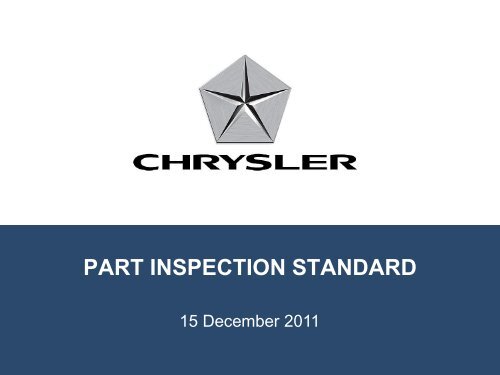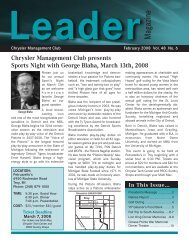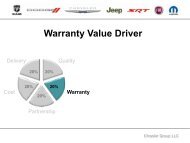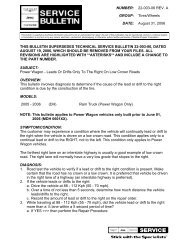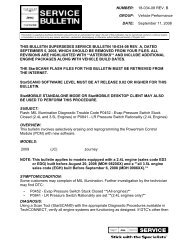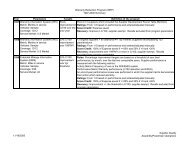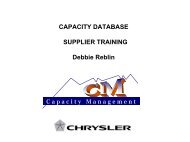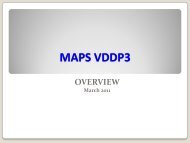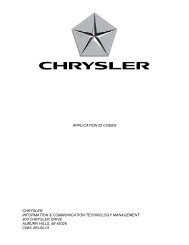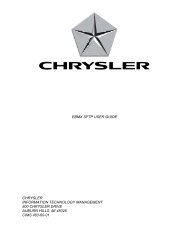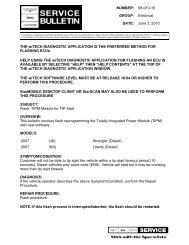PART INSPECTION STANDARD - Chrysler
PART INSPECTION STANDARD - Chrysler
PART INSPECTION STANDARD - Chrysler
You also want an ePaper? Increase the reach of your titles
YUMPU automatically turns print PDFs into web optimized ePapers that Google loves.
<strong>PART</strong> <strong>INSPECTION</strong> <strong>STANDARD</strong><br />
15 December 2011
AGENDA<br />
What is the Part Inspection Standard (Part I/S)?<br />
Why do we need Part Inspection Standard?<br />
How is the Part I/S process done?<br />
Part Inspection Standard checklist<br />
Frequently asked questions<br />
Upcoming Improvements<br />
Questions?<br />
2
What is the Part I/S?<br />
Provides clear communication and agreement between the<br />
<strong>Chrysler</strong> Manufacturing Plant, Engineering, Supplier Quality and<br />
the Supplier.<br />
Characteristics on the design model<br />
for the <strong>Chrysler</strong> Manufacturing Plant<br />
Measurement method, sample size, frequency<br />
by the Supplier<br />
3
What is the Part I/S? (cont.)<br />
Provides the <strong>Chrysler</strong> Manufacturing Plant a tool to more<br />
quickly identify a problem and responsibility when a<br />
quality issue occurs<br />
Gives the AQP team an opportunity to identify potential<br />
problems/conflicts between individual part requirements<br />
and <strong>Chrysler</strong> Build Objectives before the prototype build<br />
phase.<br />
4
Why do we need the Part I/S?<br />
Example:<br />
There was a water leak between the Flipper Glass and the<br />
Weatherstrip on one of our vehicles. The GD&T for the Glass<br />
identified points along the edges for measurement.<br />
However, the Glass sealed to the Weatherstrip about 2” inboard<br />
of the edge, which is where the plant was measuring.<br />
Where GD&T<br />
identified and the<br />
supplier measured.<br />
Where the weatherstrip<br />
sealed and the plant<br />
measured.<br />
5
Why do we need the Part I/S? (cont.)<br />
When a potential issue occurs (previous state):<br />
Potential Issue<br />
detected<br />
Plant Quality<br />
Center notified;<br />
Investigation begins<br />
Call Supplier<br />
Check CATIA /<br />
GD&T<br />
Review datums /<br />
dimensions<br />
Find standards<br />
in ADRESS<br />
Ask how Supplier<br />
checks the part<br />
Request Control<br />
Plan<br />
Ask Supplier to<br />
check some parts<br />
Find and review<br />
Boundary Samples<br />
if available<br />
Review Appearance<br />
standards /<br />
Craftsmanship results<br />
Check parts<br />
in plant<br />
Wait for / receive<br />
control plan<br />
Wait for / receive<br />
part data<br />
Determine issue<br />
responsibility<br />
Review information<br />
Begin Cor.<br />
Actions<br />
6
Why do we need the Part I/S? (cont.)<br />
With the Part I/S:<br />
Potential Issue<br />
detected<br />
Plant Quality<br />
Center notified;<br />
Investigation begins<br />
Review parts<br />
Against Part I/S<br />
Review Supplier<br />
Part I/S data<br />
Determine issue<br />
responsibility<br />
Begin Cor.<br />
Actions<br />
Much more efficient and less time wasted determining responsibility<br />
7
Who is involved with the Part I/S?<br />
AQP Team Members (minimum):<br />
• <strong>Chrysler</strong>:<br />
Supplier Quality<br />
Engineer<br />
Design / Release<br />
Engineer<br />
Plant Quality Center<br />
Engineer<br />
• Supplier:<br />
Quality Manager<br />
Engineering / Program<br />
Manager<br />
Additional team members may be added, as needed. Examples<br />
include the <strong>Chrysler</strong> Dimensional Engineer, Design Office, TAG<br />
representative, etc.<br />
8
Part I/S RASIC<br />
Supplier<br />
Supplier Quality<br />
System & Component Engineering<br />
Vehicle Engineering<br />
Manufacturing Quality (Plant)<br />
Selection of Parts C CS C RA C<br />
Confirm Assembly vs Part Datum Scheme Alignment 1<br />
R/S C C/R A<br />
Selection of Critical Dimensions 1<br />
R/S C C/R A<br />
Sample Size and Frequency determination R A C C<br />
Measurement Method of Critical Dimensions R S A C<br />
Selection of Appearance Specs/Characteristics 1<br />
R/S C C/R A C S<br />
Boundary Sample Creation and Review/Sign-off R S C A S S<br />
Selection of Functional Specs/Characteristics 1<br />
R/S C C/R A<br />
Completion of Part I/S form R S CA<br />
Retention of Completed Part I/S RA I I I I I<br />
Design Office<br />
Responsible - Those who do the work to achieve the task. There is typically one role with a participation type of Responsible<br />
Accountable - Final Approving Authority<br />
Support - Resources allocated to Responsible<br />
Informed - Those who are kept up-to-date on progress, often only on completion of the task or deliverable; and with whom there is just one way<br />
Consulted -Those whose opinions are sought; and with whom there is two-way communication<br />
NOTES<br />
1: Dependant upon which party is design-responsible<br />
9
How is the Part I/S Process Done?<br />
<strong>Chrysler</strong> Product Creation Process (CPCP)<br />
IRE FPSC PSO &<br />
PPAP<br />
CREATION<br />
DRAFT<br />
FINAL<br />
<strong>PART</strong> <strong>INSPECTION</strong> <strong>STANDARD</strong><br />
10
How is the Part I/S Process Done? (cont.)<br />
Part I/S Creation Phase<br />
• Scope of the program is defined (parts identified,<br />
important characteristics identified, etc.)<br />
• Document is created<br />
Identify Parts<br />
& Provide<br />
Information<br />
Create<br />
Part I/S<br />
Team Review<br />
Revise &<br />
Sign<br />
11
How is the Part I/S Process Done? (cont.)<br />
1. Identify Parts requiring Part I/S<br />
20 weeks prior to the VP MRD<br />
All parts with a “High” Initial Risk Evaluation (IRE) – SQE<br />
Additional parts selected by the Plant Quality Center Manager<br />
Product Team SQ sends list of parts (including those with an IRE and<br />
without) to Plant QCM & SQEs<br />
Plant QCM identifies Medium/Low/non-risked parts that also require the<br />
Part I/S and forwards to Product Team SQ & Engineering for feedback<br />
Team should agree to additional parts selected (or removed)<br />
Product Team SQ flags additional selected parts in CQMS<br />
12
How is the Part I/S Process Done? (cont.)<br />
2. Identify Characteristics for inclusion<br />
Inputs:<br />
Lessons Learned (Supplier and SQE)<br />
Design model (from engineering)<br />
Released part prints (GD&T)<br />
Complete Vehicle Quality Standard (CVQS)<br />
Build Objectives (from Plant QC)<br />
13
How is the Part I/S Process Done? (cont.)<br />
2. Identify Characteristics for inclusion<br />
Characteristics to include, consider:<br />
Key and safety characteristics (, , )<br />
Characteristics included in, or related to the CVQS<br />
Characteristics related to quality issues, especially yardholds<br />
Customer interface / impact characteristics<br />
Fit & Finish requirements<br />
Characteristics related to build issues in our plants<br />
Any other characteristics deemed critical by a member of the<br />
Team<br />
The Plant QC has final approval<br />
Product characteristics only (not process)<br />
14
How is the Part I/S Process Done? (cont.)<br />
3. Create initial Part I/S Draft and submit to Team<br />
At least 12 weeks prior to VP MRD<br />
SQE uploads into the Part I/S database upon receipt<br />
15
How is the Part I/S Process Done? (cont.)<br />
Page 1 (Drawing or Sketch)<br />
Requirements:<br />
Show sketch / drawing of entire<br />
part<br />
Show all datums for part<br />
mounting<br />
Identify attachments to mating<br />
components<br />
Track document revision history<br />
Other suggestions: attach GD&T,<br />
photos, etc.<br />
<strong>PART</strong> <strong>INSPECTION</strong> <strong>STANDARD</strong><br />
VEHICLE MY / FAMILY: 2011 WK DATE: 10/14/2009<br />
<strong>PART</strong> NO: 12345678AD <strong>PART</strong> NAME/DESC: WIDGET RH FR<br />
DRAWING/SKETCH<br />
REV.<br />
CHRYSLER<br />
SUPPLIER<br />
REVISION / DESCRIPTION<br />
DATE<br />
# PLANT QC SQE ENG QLTY MGR ENG<br />
Plant QC Eng. - <strong>Chrysler</strong><br />
SQE - <strong>Chrysler</strong><br />
INITIAL SIGN-OFF / APPROVAL<br />
TITLE NAME<br />
SIGNATURE<br />
Engineer - <strong>Chrysler</strong><br />
Quality Mgr. - Supplier<br />
Engineering - Supplier<br />
DRAFT<br />
FINAL<br />
SUPPLIER CODE: 54321 A SUPPLIER NAME: ACME Industries MANUFACTURING LOCATION:<br />
Somewhereville, USA<br />
DRAWING NO. / REVISION LEVEL: 12345678AD / B<br />
.25 ± .02<br />
02<br />
DATE<br />
16
How is the Part I/S Process Done? (cont.)<br />
Page 2 (Characteristics List)<br />
Requirements:<br />
Sections and views shown<br />
Datums shown for dimensional<br />
characteristics<br />
Identify performance requirements<br />
(customer interface)<br />
List appearance criteria (if<br />
applicable)<br />
Identify inspection points<br />
Detail specifications and tolerances<br />
Identify measurement methods and<br />
gages used<br />
List sample sizes and frequencies<br />
<strong>PART</strong> <strong>INSPECTION</strong> <strong>STANDARD</strong><br />
VEHICLE MY / FAMILY: 2011 WK DATE: 10/14/2009<br />
<strong>PART</strong> NO: 12345678AD <strong>PART</strong> NAME/DESC: WIDGET RH FR<br />
ITEM<br />
#<br />
CHARACTERISTIC /<br />
<strong>INSPECTION</strong> POINT<br />
SPECIFICATION /<br />
TOLERANCE<br />
MEAS.<br />
METHOD<br />
SAMPLE<br />
SIZE<br />
FREQ.<br />
1 Surface profile Gage 123-4 5 pcs 2/shift<br />
2 Appearance<br />
No flash<br />
No burrs<br />
Visual<br />
No sinks<br />
100% 100%<br />
Plant QC Eng. - <strong>Chrysler</strong><br />
SQE - <strong>Chrysler</strong><br />
Engineer - <strong>Chrysler</strong><br />
Quality Mgr. - Supplier<br />
Engineering - Supplier<br />
DRAFT<br />
FINAL<br />
SUPPLIER CODE: 54321 A SUPPLIER NAME: ACME Industries MANUFACTURING LOCATION:<br />
Somewhereville, USA<br />
DRAWING NO. / REVISION LEVEL: 12345678AD / B<br />
REMARKS / <strong>INSPECTION</strong> METHOD<br />
INITIAL SIGN-OFF / APPROVAL<br />
TITLE NAME SIGNATURE<br />
DATE<br />
17
How is the Part I/S Process Done? (cont.)<br />
4. Team reviews initial Part I/S Draft<br />
The SQE coordinates the meeting<br />
A team meeting at the assembly plant, in front of the vehicle with<br />
parts available, is preferred<br />
Other methods may be used as necessary (web conference,<br />
phone conference, etc.)<br />
The Part I/S team reviews the document (using the page 3<br />
checklist as a guide)<br />
The Team identifies any changes needed to the document<br />
The Plant QCE has final approval authority<br />
18
How is the Part I/S Process Done? (cont.)<br />
5. Revise the Part I/S per Team requirements and<br />
resubmit for Team review<br />
The Part I/S is intended as a tool to ensure agreement with the<br />
<strong>Chrysler</strong> Plant’s and Supplier’s measurement schemes. While<br />
continuous improvement is desired (and necessary), the Part I/S is<br />
not intended as an opportunity to conduct a ‘part redesign’ at the<br />
pilot stage.<br />
6. Team signs the Part I/S Draft<br />
Engineer - <strong>Chrysler</strong><br />
Quality Mgr. - Supplier<br />
Engineering - Supplier<br />
The Supplier keeps original and copies the other team members<br />
The SQE uploads a scanned copy of the signed Draft to the Part I/S<br />
database (6a)<br />
Plant QC Eng. - <strong>Chrysler</strong><br />
SQE - <strong>Chrysler</strong><br />
INITIAL SIGN-OFF / APPROVAL<br />
TITLE NAME<br />
SIGNATURE<br />
DATE<br />
19
How is the Part I/S Process Done? (cont.)<br />
• Use of the Part I/S Draft to check parts for the VP and<br />
PVP pilot builds<br />
• Follows the same basic flow for each build:<br />
Implement &<br />
Collect Data<br />
Part I/S Draft Phase<br />
Build<br />
Event<br />
Team Review<br />
Revise &<br />
Resubmit<br />
20
How is the Part I/S Process Done? (cont.)<br />
7. & 10. Implement Part I/S Draft; submit data to the Team<br />
Supplier uses the Part I/S Draft to check the parts to be sent in to<br />
<strong>Chrysler</strong> for the applicable build (VP / PVP) or build phase<br />
Data is sent to the <strong>Chrysler</strong> Team members two weeks prior to the<br />
build MRD<br />
• SQE uploads the data into the Part I/S database (7a & 10a)<br />
8. & 11. Team reviews data and build issues<br />
The Part I/S Team reviews the provided data, as well as any issues<br />
from the applicable build (VP / PVP) or build phase<br />
The Team determines what changes (if any) are required<br />
The Plant QCE has final approval on required Part I/S changes<br />
21
How is the Part I/S Process Done? (cont.)<br />
9. & 12. Revise Part I/S per Team requirements<br />
The Supplier revises the Part I/S Draft per Team requirements<br />
and resubmits to the Team<br />
The Team initials the form for each revision that takes place<br />
The above steps should be repeated for each build phase, if<br />
applicable (i.e. VP A, VP B, etc.)<br />
22
How is the Part I/S Process Done? (cont.)<br />
Part I/S Final Phase<br />
• Part I/S is finalized for Job 1 and continuing volume<br />
production<br />
• The Part I/S remains a living document and can be<br />
revised as needed<br />
23
How is the Part I/S Process Done? (cont.)<br />
13.Change Part I/S status to Final<br />
Supplier changes status of Part I/S to “Final” from “Draft”<br />
Supplier submits to the team for signatures<br />
14.Team signs the Part I/S Final<br />
The Supplier keeps original and copies the other team members<br />
The SQE uploads a scanned copy of the signed Final to the Part<br />
I/S database (14a)<br />
15.Implement Part I/S Final for Job 1 and volume<br />
production<br />
Supplier uses the Part I/S Final to check parts going forward<br />
Data is retained by the Supplier for review upon request by<br />
<strong>Chrysler</strong> personnel<br />
24
How is the Part I/S Process Done? (cont.)<br />
Issue Possibly Requiring Part I/S Change:<br />
a. Process Change or Internal Resource (via Forever<br />
Requirements)<br />
b. Quality Issue (at the <strong>Chrysler</strong> Plant or Supplier Facility)<br />
c. Engineering Change Notice (CN)<br />
16.Revise and Re-submit<br />
As necessary (with all other Quality Documents)<br />
Supplier updates in the Revision section and resubmits to the<br />
Team<br />
17.Team initials revision<br />
SQE uploads revision into Part I/S database (17a)<br />
25
Part I/S and Other Quality Documents<br />
Process Failure Mode and Effect Analysis<br />
Control Plan<br />
Part I/S FPSC LPA. Work Instructions<br />
26
Part I/S and Other Quality Documents (cont.)<br />
FPSC: “Safe Launch”; checks/inspections over and above<br />
Control Plan<br />
Control Plan: Controls (w/ frequency, sample size) for<br />
entire process<br />
Part I/S: Ties controls for the final product characteristics<br />
with visual representation (GD&T) and allows for<br />
measurement scheme agreement with the <strong>Chrysler</strong><br />
Manufacturing Plant<br />
27
<strong>PART</strong> <strong>INSPECTION</strong> <strong>STANDARD</strong> CHECKLIST
<strong>PART</strong> <strong>INSPECTION</strong> <strong>STANDARD</strong> CHECKLIST<br />
There is a 19-item checklist in the Part I/S.<br />
The checklist is based on the Part I/S process standard.<br />
All suppliers must self-check their Part I/S using the<br />
checklist before the submission.<br />
SQE shall verify the checklist before upload into the Part<br />
I/S database.<br />
29
How is the Part I/S Process Done? (cont.)<br />
30
6<br />
7<br />
8<br />
9<br />
10<br />
11<br />
12<br />
13<br />
14<br />
15<br />
16<br />
17<br />
18<br />
19<br />
How is the Part I/S Process Done? (cont.)<br />
CHARACTERISTICS/MEASUREMENT POINTS: All measurement<br />
points are identified on the part sketch and labeled / numbered to<br />
correspond with the Item # on Sheet 2<br />
CHARACTERISTICS/MEASUREMENT POINTS: Measurement points<br />
on the part are the same as those being measured when on the<br />
vehicle (reference the CVQS), if applicable<br />
CHARACTERISTICS/MEASUREMENT POINTS: Characteristics<br />
include dimensional, functional, and appearance requirements<br />
(material, environmental, durability, and weight requirements are not<br />
mandated for inclusion)<br />
TOLERANCES & SPECIFICATIONS: Tolerances and specifications<br />
for all characteristics are included<br />
TOLERANCES & SPECIFICATIONS: Boundary samples (e.g. go/nogo,<br />
appearance samples, etc.) are referenced (as applicable)<br />
TOLERANCES & SPECIFICATIONS: Tolerances and specifications<br />
for the part do not conflict with those on the CVQS, if applicable<br />
TOLERANCES & SPECIFICATIONS: When the CVQS measures a<br />
characteristic referencing two parts (e.g. a gap between two separate<br />
parts), the tolerance on each referenced part does not take up more<br />
than half of the CVQS tolerance (i.e. no potential interference<br />
conditions), if applicable<br />
GAGES & MEASUREMENT EQUIPMENT: All gages and<br />
measurement equipment used to check each characteristic are<br />
identified<br />
GAGES & MEASUREMENT EQUIPMENT: Gages and measurement<br />
equipment are adequate to check the characteristic they are identified<br />
for<br />
SAMPLE SIZES & FREQUENCIES: Number of parts checked for<br />
each characteristic is identified and adequate<br />
SAMPLE SIZES & FREQUENCIES: Frequency of parts being<br />
checked is identified and adequate<br />
SAMPLE SIZES & FREQUENCIES: Sample sizes and frequencies<br />
match those shown on the Control Plan<br />
SKETCHES & DRAWINGS: Part sketches are clear and legible<br />
SKETCHES & DRAWINGS: Sections and/or sketches are shown for<br />
each characteristic<br />
31
FREQUENTLY ASKED QUESTIONS
Frequently Asked Questions<br />
1. Is the Part I/S required to be „waterfalled‟ to Tier 2 and<br />
lower Suppliers?<br />
No, this is not mandated at this time. Cascading this process to Tier 2<br />
and lower Suppliers is at the discretion of the Tier 1 Supplier.<br />
Exception: “Directed” and “Consigned” parts<br />
2. Clarify how changes to the Part I/S are made via the<br />
Forever Requirement (FR) system.<br />
The Part I/S is considered another quality document that must be kept<br />
updated whenever a CN, FR notice, or Resource Notice is issued. I.e.,<br />
the FR system would be used for the process change as a whole, NOT<br />
just for the Part I/S.<br />
3. What is the process for accepting a part that doesn‟t<br />
meet the Part I/S requirements?<br />
No different than the current process; the Part I/S does not add<br />
requirements that do not currently exist, nor does it modify<br />
requirements from other documents. If the part does not meet<br />
<strong>Chrysler</strong>‟s specifications, than a deviation is handled as it would<br />
normally be (such as via an IAA).<br />
33
Frequently Asked Questions<br />
4. When does the Part I/S process end?<br />
It is a living document and is used throughout the product lifecycle. It is<br />
not specific to a program phase, nor is there a set duration.<br />
5. Will I receive an NCT/eCIMS for issues if the<br />
characteristics are not included on the Part I/S?<br />
YES. The Part I/S is not the “end-all” for inspection, nor is it to be<br />
considered a comprehensive list of <strong>Chrysler</strong> requirements.<br />
6. Should the Part I/S include characteristics already on<br />
the Control Plan?<br />
YES! In fact, it is required that any characteristic listed on the Part I/S<br />
also be included on the Control Plan.<br />
34
Frequently Asked Questions<br />
7. If I‟m shipping a part to multiple <strong>Chrysler</strong> Manufacturing<br />
Plants, do I need to make a Part I/S for each one?<br />
No. Include the Plant QCE from each applicable <strong>Chrysler</strong> facility on the<br />
team (and each SQE/Engineer, as required), with the Lead<br />
program/plant personnel taking the lead on the team. Ensure the Part<br />
I/S includes the input from all of the manufacturing plants<br />
8. If we‟re instituting 100% inspection for VP (or other pilot<br />
build), with a gradual lessening of frequency as we<br />
move into production, should the Part I/S reflect this?<br />
35
UPCOMING IMPROVEMENTS
Upcoming Improvements<br />
Part Inspection Standard integrated with First Production Shipment<br />
Certification (FPSC):<br />
No process change for Part I/S and FPSC requirements.<br />
Part I/S and FPSC forms will be combined to reduce paperwork.<br />
FPSC only parts will be required to fill out only the Characteristics List page<br />
(similar to the current “Page 2”). No <strong>Chrysler</strong> plant approval required.<br />
Part I/S required parts will still be required to fill out all pages and obtain<br />
the <strong>Chrysler</strong> plant approvals beside the AQP team.<br />
The Measurement Method, Sample Size and Frequency may be specified<br />
differently during VP, PS and V1 stages.<br />
37
Upcoming Improvements<br />
Part Inspection Standard integrated with First Production<br />
Shipment Certification (FPSC)<br />
<strong>PART</strong> <strong>INSPECTION</strong> <strong>STANDARD</strong><br />
(Use this sheet also for First Production Shipment Certification)<br />
VEHICLE<br />
MY / FAMILY:<br />
<strong>PART</strong> NO: <strong>PART</strong> NAME/DESC: YES NO<br />
SUPPLIER<br />
CODE:<br />
SUPPLIER<br />
NAME:<br />
SPECIFICATION /<br />
TOLERANCE<br />
Req'd for<br />
8-Stage?<br />
(Y / N)<br />
MILESTON<br />
E<br />
MEAS.<br />
METHOD<br />
LOCATION:<br />
NOTE: Complete the Characteristics List sheet only to fulfil FPSC requirements and gain approvals by <strong>Chrysler</strong> SQE and<br />
engineer per AQP / PSO requirements and timing.<br />
ITEM<br />
#<br />
CHARACTERISTIC /<br />
<strong>INSPECTION</strong> POINT<br />
DRAWING NO.<br />
REVISION LEVEL:<br />
DATE:<br />
SAMPLE<br />
SIZE<br />
Plant Approval Required?<br />
FREQ. REMARKS / <strong>INSPECTION</strong> METHOD<br />
38<br />
x
Upcoming Improvements<br />
Part Inspection Standard with Electronic Approvals:<br />
Electronic Approvals is to speed up the approval process within <strong>Chrysler</strong><br />
and improve the quality of the part I/S.<br />
No process change for Part Inspection Standard requirements.<br />
No change for the submission of Part I/S by the Suppliers. The Suppliers<br />
need to complete the Part Inspection Standard and self-audit with the<br />
19-point checklist before submitting to SQEs.<br />
The SQEs will upload the Part I/S into the <strong>Chrysler</strong> database and send for<br />
electronic approvals by the <strong>Chrysler</strong> Design Release Engineer and Plant<br />
Quality Center Engineer (QCE).<br />
Escalation emails will be automatically sent to the management if not<br />
approved within a given time period.<br />
Approvals and rejections will be based on the 19-point checklist.<br />
Database programming has been completed and is being debugged.<br />
Timing TBD<br />
39
Where do I find information?<br />
Part I/S Process<br />
Global Sourcing Book of Knowledge (unavailable to Suppliers)<br />
PDF copy of the process available on the AQP/PSO website (see below)<br />
Part I/S Form<br />
AQP/PSO website (https://gsp.extra.chrysler.com/qlty/pso/index.html;<br />
Suppliers can access via the “References” section of the <strong>Chrysler</strong> Portal<br />
on COVISINT)<br />
Part I/S Database<br />
Lotus Notes; partnered with the CVQS database (unavailable to<br />
Suppliers)<br />
40
Contact Information<br />
Supplier Primary Contact: Applicable Supplier Quality<br />
Engineer<br />
Part I/S Process: Stanley Zhou<br />
stanley.zhou@chrysler.com<br />
CVQS Process: Chi-Chang (Mike) Lee<br />
cl88@chrysler.com<br />
41
QUESTIONS?<br />
COMMENTS?


